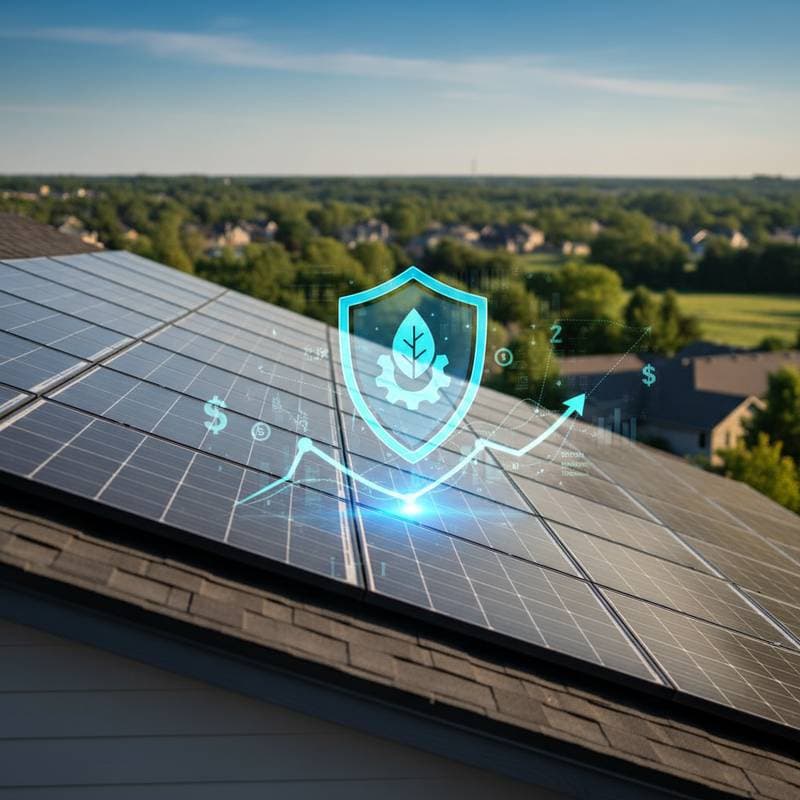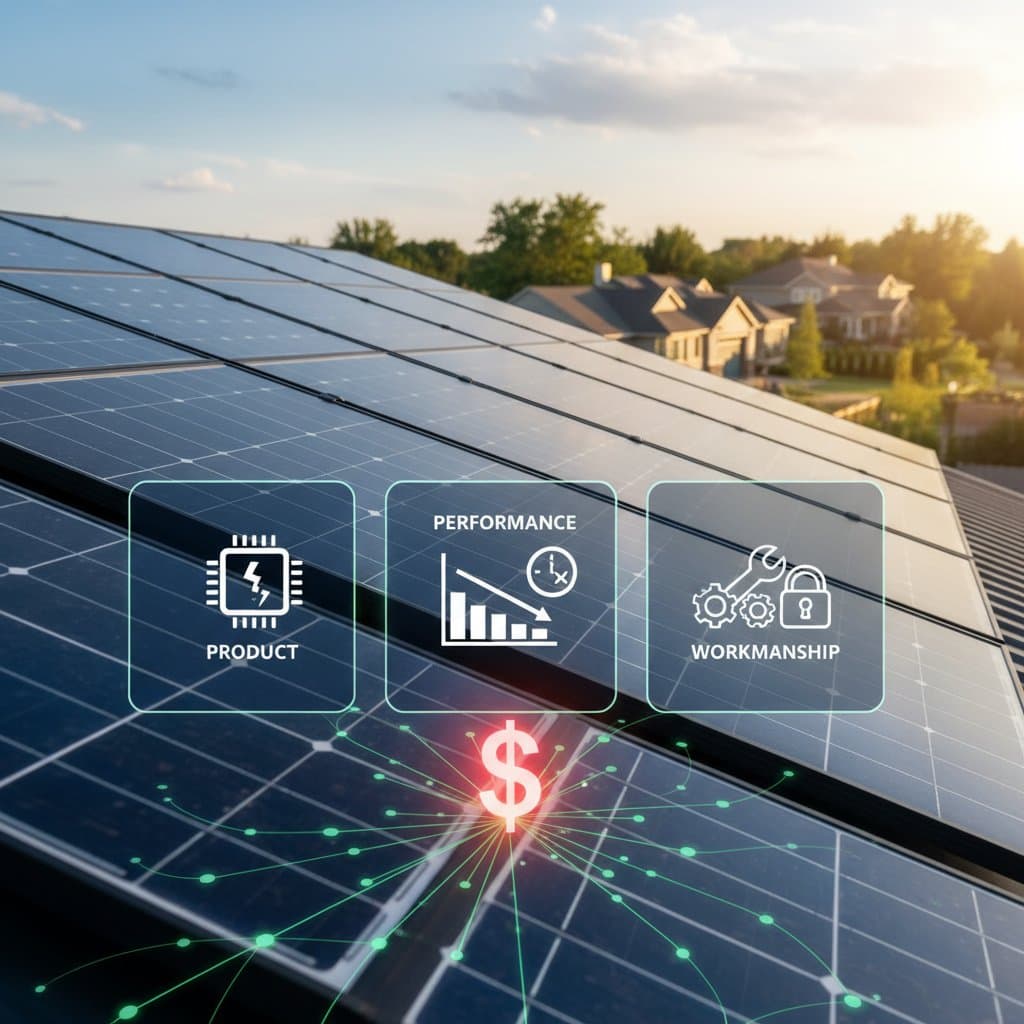How Much Does a Home Warranty for Solar Panels Cost? Complete Pricing Guide
Home warranties for solar panels protect renewable energy systems from unexpected repair bills and performance failures. Professional solar warranty plans range from $300 to $900 per year, with most homeowners paying approximately $600 annually for standard coverage. Total costs depend on system size, coverage level, and equipment age. Regional factors, such as sunlight intensity and contractor availability, also influence pricing. Data from the Solar Energy Industries Association indicates that a well-structured solar warranty can extend system lifespan by up to 25 percent, positioning it as an essential safeguard for one of the most valuable home energy investments.
Solar warranties mitigate risks from inverter failures, panel degradation, and electrical component damage. These plans cover labor and replacement costs that standard manufacturer warranties frequently exclude. Homeowners who select appropriate solar protection plans enjoy predictable expenses and peace of mind. The right policy maintains consistent energy performance and lowers long-term repair costs.
Detailed Cost Breakdown
Solar panel warranty pricing follows a predictable pattern based on system capacity and coverage complexity. Most providers charge per kilowatt (kW) of installed capacity. Average home systems range from 5 to 10 kW. Typical prices fall between $60 and $100 per kilowatt annually, leading to total costs of $300 to $900 per year. Companies such as Cinch Home Services and American Home Shield provide renewable energy add-ons to standard home warranties at comparable rates.
Primary Pricing Structure
- Minimum service charge: $75 per visit serves as the standard for warranty dispatch calls.
- 25th percentile cost: Approximately $400 annually for small systems under 5 kW.
- 50th percentile (median): $600 annually for balanced coverage on 7 kW systems.
- 75th percentile: $850 or higher for comprehensive protection that includes inverters and monitoring systems.
Regional averages reveal slightly higher rates in sunny southern states, where system usage proves greater. Northern markets often experience lower costs due to less frequent demand for solar repairs.
Size and Scope Factor
System capacity directly impacts warranty cost. Each additional 1 kW of solar capacity adds roughly $75 to $100 per year to the premium. A homeowner with a 6 kW system might pay around $600 annually, whereas a large 10 kW installation could reach $950. Larger systems involve more panels and wiring, which heightens potential repair exposure. For instance, replacing a damaged inverter on a 10 kW system can exceed $2,000 without warranty coverage, underscoring the value of extended protection.
Material and Quality Tiers
Warranty cost varies with system quality and component brand. Entry-level systems featuring panels from manufacturers like Renogy or BougeRV typically require mid-range warranty coverage due to shorter equipment warranties. Such plans cost around $400 to $600 annually. Mid-tier systems with Q Cells or Canadian Solar panels benefit from longer manufacturer warranties, which diminish the need for high-end service coverage. Premium systems using SunPower or REC Solar modules may warrant higher premiums, often $800 to $1,000 annually, given their greater system value and performance guarantees. Many of these plans incorporate 25-year degradation protection and inverter replacement coverage.
Complexity Variables
Accessibility, roof design, and electrical configuration influence warranty pricing. Systems on multi-story homes or steep roofs may elevate labor costs, resulting in higher premiums. Existing conditions, such as outdated wiring or panel misalignment, can further increase prices. Code compliance updates and regional labor shortages add to rate variations. Geographic multipliers indicate that warranty costs in coastal regions average 10 to 15 percent higher owing to elevated service fees and humidity-related degradation risks.
Service Types and Comprehensive Pricing
Solar warranty providers generally offer two main service tiers: standard and premium. Each tier addresses distinct homeowner needs and performance expectations.
Basic or Standard Service Package
Standard solar warranty plans typically include the following:
- Coverage for panel defects and inverter malfunctions.
- Labor costs for approved repairs.
- Annual maintenance inspections.
- System monitoring support.
These packages range from $400 to $650 per year. Labor often constitutes half the expense, averaging $200 to $300 annually. Standard plans suit homeowners with mid-range panels backed by stable manufacturer warranties and predictable energy output. They fit systems under 7 kW in areas with reliable maintenance access.
Premium or Comprehensive Service Package
Comprehensive solar warranties extend coverage to power optimizers, racking damage, and surge protection. Many include remote performance monitoring and emergency service availability. These plans range from $750 to $1,100 per year, marking a 30 to 40 percent premium over standard options. The elevated cost yields benefits through minimized downtime and extended system life. Premium policies deliver an estimated return on investment of 10 to 15 percent by averting expensive inverter replacements and optimizing efficiency amid variable weather conditions.
Add-on Services Matrix
| Add-on Service | Cost Range | Bundle Savings | Benefit |
|---|---|---|---|
| Battery warranty extension | $200–$400 | 10% | Protects lithium batteries like Tesla Powerwall |
| Roof leak coverage | $100–$250 | 8% | Covers water intrusion from mounting points |
| Performance guarantee | $75–$150 | 5% | Ensures energy production benchmarks |
| Smart monitoring system | $150–$300 | 7% | Tracks system output remotely |
Bundling two or more add-ons can lower total costs by 10 to 15 percent. Platforms such as HomeAdvisor and Angi facilitate direct comparisons among multiple providers, aiding homeowners in selecting the most cost-efficient combinations.
Professional vs. DIY Analysis
DIY Cost Breakdown
Managing solar repairs without professional coverage may seem less expensive at first but frequently escalates into significant outlays. A basic replacement inverter costs $1,200 to $2,000, plus $250 to $500 in labor if hired independently. DIY repairs demand specialized tools, including multimeters, torque wrenches, and safety harnesses, which can surpass $400 in purchases or rentals. The learning curve adds time costs, with homeowners dedicating 10 to 20 hours to research on installation and warranty requirements. Overall, self-managed maintenance averages $1,000 to $2,500 annually when factoring in equipment wear and potential errors.
Professional Advantages
Professionals deliver clear benefits, such as certified diagnostics, factory-trained technicians, and insured workmanship. Providers like TruHome Warranty and Select Home Warranty ensure service call reliability and access to specialized equipment valued in the thousands. Professional plans conserve 20 to 30 hours per year in maintenance time for homeowners. Insurance-backed warranties also address accidental damage unclaimable under DIY approaches. The expertise premium proves worthwhile, as one major inverter or roof penetration failure can surpass three years of warranty fees.
Decision Framework
Opt for professional coverage if the following apply:
- The system exceeds 5 kW capacity.
- Solar supplies more than half of household energy.
- The home features limited roof access or complex wiring.
DIY approaches suit only ground-mounted or micro systems under 3 kW with straightforward labor access. The expenses from errors, like wiring shorts or roof leaks, rapidly negate initial DIY savings.
Actionable Cost-Saving Strategies
Timing Optimization
Solar warranty providers frequently adjust pricing with seasons. Securing coverage during off-peak months can yield savings up to 15 percent. Weekday service calls may cut dispatch fees by $25 to $50 relative to weekend visits. Certain providers extend renewal discounts for multi-year commitments.
Smart Shopping Tactics
Request at least three quotes via comparison platforms. Analysis from ConsumerAffairs reveals that homeowners comparing multiple providers save an average of 18 percent on total warranty costs. Negotiating annual prepayment can produce 5 to 10 percent savings. Local co-op programs sometimes enable group purchasing to reduce administrative fees.
Preparation Actions
Homeowners can trim costs through preliminary maintenance prior to inspections. Cleaning panels, verifying wiring visibility, and recording inverter readings can conserve $50 to $100 in technician time. Clear provider communication ensures precise quotes and prevents superfluous service calls.
Market Dynamics and Considerations
Geographic Variations
Solar warranty pricing differs across metropolitan areas. Urban regions with elevated labor costs, such as coastal markets, incur premiums of 10 to 20 percent. Rural areas may encounter fewer provider options, potentially increasing prices through travel surcharges. Sunbelt states benefit from competitive pricing due to widespread solar adoption and service density.
Market Timing
Material costs and labor availability shape warranty pricing. Supply chain fluctuations impact inverter replacement costs, which may elevate premiums during component shortages. Inflation adjustments generally raise warranty rates by 3 to 5 percent annually, although multi-year contracts secure lower rates.
Value Indicators
A robust solar warranty bolsters property value by guaranteeing steady system performance. Studies from real estate platforms demonstrate that homes with transferable solar warranties command 2 to 4 percent higher sale prices than those without. Retained energy savings and avoided maintenance further enhance financial advantages over the system's lifespan.
Enhancing Long-Term Solar Benefits
Investing in a suitable solar warranty safeguards against unforeseen expenses while optimizing system efficiency. Homeowners gain reliable energy production and increased home value through comprehensive coverage. Evaluate options based on system specifics to secure the best protection and realize sustained savings from solar energy.



